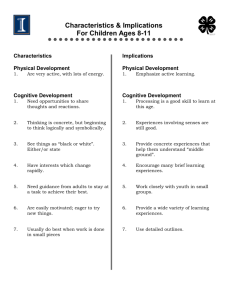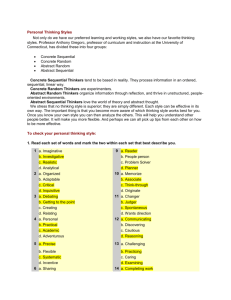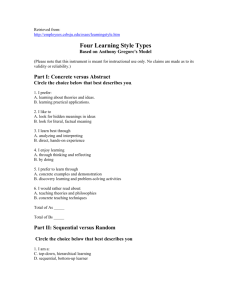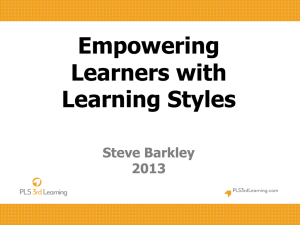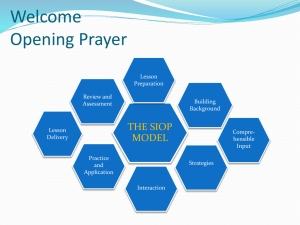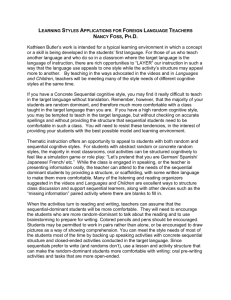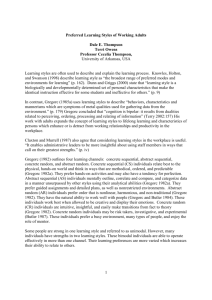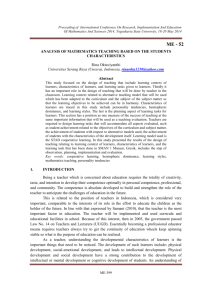Gregorc Overview
advertisement
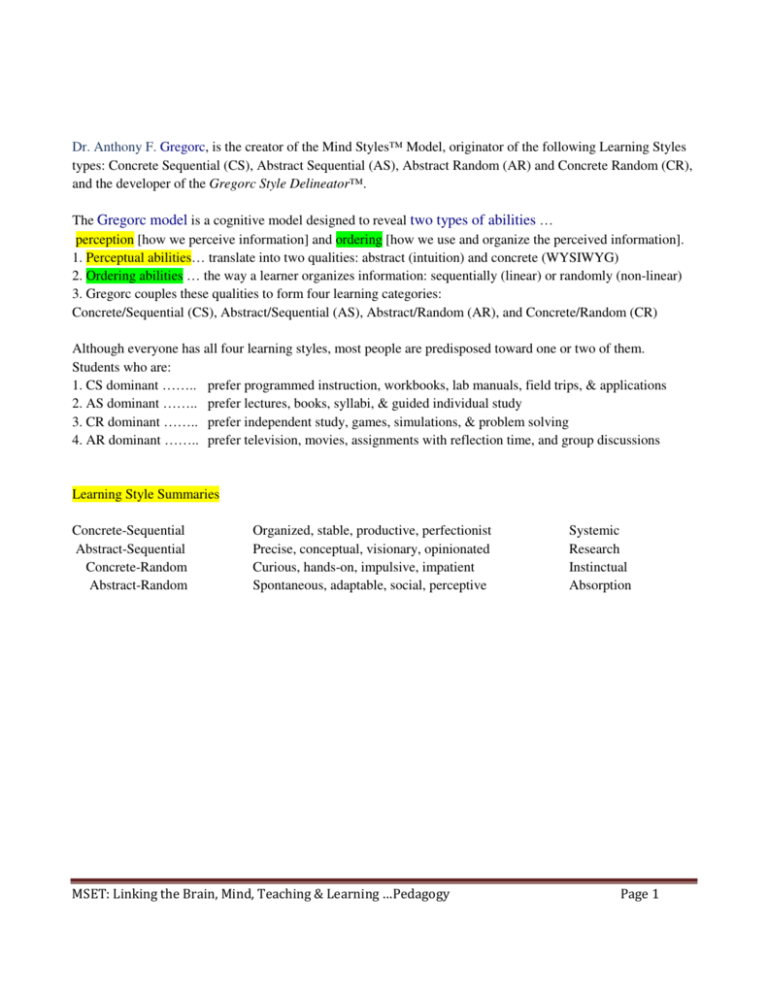
Dr. Anthony F. Gregorc, is the creator of the Mind Styles™ Model, originator of the following Learning Styles types: Concrete Sequential (CS), Abstract Sequential (AS), Abstract Random (AR) and Concrete Random (CR), and the developer of the Gregorc Style Delineator™. The Gregorc model is a cognitive model designed to reveal two types of abilities … perception [how we perceive information] and ordering [how we use and organize the perceived information]. 1. Perceptual abilities… translate into two qualities: abstract (intuition) and concrete (WYSIWYG) 2. Ordering abilities … the way a learner organizes information: sequentially (linear) or randomly (non-linear) 3. Gregorc couples these qualities to form four learning categories: Concrete/Sequential (CS), Abstract/Sequential (AS), Abstract/Random (AR), and Concrete/Random (CR) Although everyone has all four learning styles, most people are predisposed toward one or two of them. Students who are: 1. CS dominant …….. prefer programmed instruction, workbooks, lab manuals, field trips, & applications 2. AS dominant …….. prefer lectures, books, syllabi, & guided individual study 3. CR dominant …….. prefer independent study, games, simulations, & problem solving 4. AR dominant …….. prefer television, movies, assignments with reflection time, and group discussions Learning Style Summaries Concrete-Sequential Abstract-Sequential Concrete-Random Abstract-Random Organized, stable, productive, perfectionist Precise, conceptual, visionary, opinionated Curious, hands-on, impulsive, impatient Spontaneous, adaptable, social, perceptive MSET: Linking the Brain, Mind, Teaching & Learning …Pedagogy Systemic Research Instinctual Absorption Page 1 Preferences: Concrete Sequential Order and quiet Exact directions Guided Practice Know the accepted way of doing something Are given approval for specific work done Abstract Sequential Lecture and reading Work alone Research Logical explanations Are respected for intellectual ability Abstract Random Cooperative work Assignments with room for interpretation Balance of social activities and work Noncompetitive atmosphere Personalized learning Personal attention and emotional support Concrete Random Hands-on experiences: trial & error approach Brainstorming and open-ended activities Produce real, but creative, products Original/unique approaches to problem solving Self-directed learning Struggles with: Concrete Sequential Making choices Open ended assignments / "what if" questions Dealing with opposing views Taking new approaches Interpreting abstract ideas Abstract Sequential Expressing emotions Working cooperatively in groups Writing creatively Taking risks or facing the unpredictable Open ended problems Abstract Random Working alone Attending to details and giving exact answers Working within time limits Concentrating on one task at a time Being corrected Expecting less emotional response from others Concrete Random Pacing and meeting time limitations Completing projects Choosing one answer Keeping detailed records Prioritizing Accepting others’ ideas without showing another way MSET: Linking the Brain, Mind, Teaching & Learning …Pedagogy Page 2 The Concrete Sequential individual: Characteristics Needs and enjoys structured situations. Likes to work with hands-on projects. Likes things to be ordered and arranged in specific ways. Likes clear and definite directions. Is always busy, looking for constructive things to do; can’t sit still for long. Is a natural organizer. Prefers to do things step by step. Follows directions. Is a natural editor, can take anything and make it better. Has a great fear of being wrong. The Abstract Sequential individual: Reads avidly for information and ideas logically presented. Needs a quiet environment to think and work. Likes to debate about ideas and controversial issues. Likes to learn just to learn - self-directed. Gathers information and analyzes ideas. Strives for intellectual recognition. Thinks in a structured, logical and organized way. Fears appearing foolish or uninformed. The Abstract Random individual: Dislikes routine procedures and orderliness. Is extremely sensitive to his/her own and others’ feelings. Is flexible, accepting and responds easily to change. Learns well through discussion and sharing of ideas. Is imaginative. Personalizes information. Is usually involved in many projects or interest at one time. Is focused on friends and relationships. Has a fear of not being liked. The Concrete Random individual: Is highly curious. Finds out-of-the-ordinary answers to problems. Seems driven to say or do things in a way others have not. Is a risk-taker. Likes to discover his/her way of doing things; must test things for self. Is extremely independent and competitive with self. Prefers to investigate and experiment; enjoys hands-on experimenting. Skips steps and details. Shows original creativity; has varied and unusual ideas. Has multiple projects going at once. Finds possibilities, creates change. Is notorious for not reading directions or instructions. Fears structure. MSET: Linking the Brain, Mind, Teaching & Learning …Pedagogy Page 3
